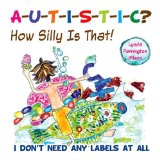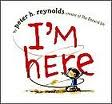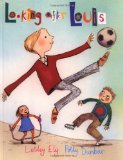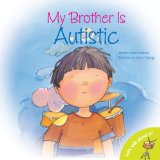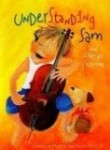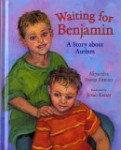Autism and Asperger Syndrome
Presenting a Selection of Autism and Asperger Syndrome Picture Books for Kids
Asperger Syndrome and Autism picture books are valuable resources for home, school and library. We recommend thinking about the variety of perspectives shown by these stories and taking time to consider the audience for each.

Elsewhere on this site ~
– Children’s Books About Bullying and Dealing with Bullies
– Children’s Books About Diversity
– Children’s Books About Family Diversity
– Children’s Books About Individuality
– Quotes about Diversity for Children
A-U-T-I-S-T-I-C? How Silly Is That! I Don’t Need Any Labels at All written and illustrated by Lynda Farrington Wilson
Picture book about labelling children with autism published by Future Horizons Inc.

Author-illustrator Lynda Farrington Wilson is a mother of a funny, brilliant, and talented sensory seeker who has autism. In A-U-T-I-S-T-I-C? How Silly Is That! I Don’t Need Any Labels at All she challenges readers to examine the labels we often attach to people on the autism spectrum.
Asking, I have brown hair, I wonder if that makes me… brown-hair-tistic? she asserts that there are many ways we might choose to label individuals but, in fact, labels are unnecessary. A child with autism is not unlike everyone else, he simply has a different approach to the world.
A-U-T-I-S-T-I-C? How Silly Is That! I Don’t Need Any Labels at All includes seventeen pages of exhuberantly illustrated text. It also includes an author’s note which explains that Ms. Farrington Wilson’s goal of encouraging the world to see past the labels and understand the importance of “people-first” language.
Autistic? How Silly is That!: I Don’t Need Any Labels at All at Amazon.com
Autistic? How Silly is That!: I Don’t Need Any Labels at All at Amazon.ca
The Friendship Puzzle: Helping Kids Learn About Accepting and Including Kids With Autism Written by Julie L. Coe, inspired by Jennifer Maloni, and illustrated by Sondra L. Brassel
Autism picture book published by Larsian Publishing, Inc.

When Mackenzie meets a new boy in her class, she tries to be his friend but he seems a little different. At recess, Dylan spends alot of time on the swings and, althought he apparently wants to play soccer with his classmates, he does not seem to know how to join in and play.
Dylan is bothered by the noise in the cafeteria and he sometimes waves his hands and makes noises. Mackenzie decides to find out how to be Dylan’s friend. She learns that Dylan ‘doesn’t have a lot of words and that it is hard for him to tell people he wants to play or be friends.’
In addition to telling the story of Dylan and Mackenzie, The Friendship Puzzle includes discussion questions and suggested activities. The authors also remind readers that it is important to praise children who reach out to and are inclusive of others.
The Friendship Puzzle is written from the perspective of a classmate.
Ian’s Walk: A Story About Autism Written by Laurie Lears and illustrated by Karen Ritz
Autism picture book published by Albert Whitman & Company

Ian’s mom is reluctant to have him go to the park with his sisters. She warns the two girls to keep a close eye on him. Enroute to the park, the children pass a diner. Ian is fascinated by the circling ceiling fan. He hardly notices the siren of a passing fire truck but seems to hear something else. Not interested in fragrant lilacs, Ian would rather put his face up to a brick wall.
Ian feels things differently … while Tara and I toss cereal to the ducks, Ian lies on the ground with his cheeks pressed against the hard stones.
Ian is non-verbal and sometimes waves his hands. Aware of how Ian is different and conscious that other people watch him, his sister acknowledges that she sometimes feels angry.
When Ian wanders away while they are all at the park, his frantic sisters race to find him. Finally, Julie tries to think as her brother does. She remembers he likes a bell and, sure enough, finds him underneath it.
As the three siblings return home, they pause to enjoy the walk and especially the sights, sounds and smells that matter to Ian.
Ian’s Walk acknowledges the frustrations of loving an autistic sibling and encourages young readers to consider a different perspective.
Beautiful watercolour illustrations enhance the narrative and lovingly depict the children’s facial expressions.
Ian’s Walk is written from the perspective of a sibling. An informative foreward provides information about the challenges faced by siblings of children with disabilities.
Ian’s Walk: A Story about Autism at Amazon.com
Ian’s Walk: A Story About Autism at Amazon.ca
I’m Here written by Peter H. Reynolds
Picture book published by Antheneum Books for Young Readers, Simon and Schuster

Written with a goal of encouraging children and adults to reach out, embrace, and appreciate children in the autism spectrum as well as anyone who is different from ourselves, I’m Here suggests that young readers rethink their ideas about a child who prefers solitude or who is not skilful at social interactions.
At recess, a young boy sits, by himself. The loud, playground voices are too much for him, I hear it all like one big noise. A big drum. Boom. Boom. Boom Boom.“This is not where the paper wants to be.” He folds the paper into an airplane and launches it heavenward. Soon, the young boy is flying in the plane, exuberant at the adventure.
A thoughtful, metaphorical picture book, I’m Here explores themes of friendship and acceptance and encourages children to look for opportunities to smile and be a friend.
Looking After Louis written by Lesley Ely and illustrated by Polly Dunbar
Autism picture book highlighting inclusion published by Albert Whitman & Company

When a new boy arrives at school, he is partnered with a girl who notices that he is not like the other children in the class. He often just sits and stares at the wall. If I ask him what he’s looking at, he says, “Looking at,” and keeps on looking.
Louis tries using his new friend’s crayons but she can’t decide what he is drawing and he can’t say. When they go outside for recess, Louis runs around with outstretched arms. He runs through the boys’ soccer game and annoys the players. When invited to join the children who are climbing on a tire, Louis does not move. He just stands and watches.
In the classroom, Louis sometimes echoes his Miss Owlie’s instructions. His classmates laugh when he sounds like her. His partner notes that he is granted more leeway to speak out than others would be given.
When one of the children arrives at school with a new soccer ball, Louis shows interest. His classmates join in the game and, each time Louis touches the ball, he is encouraged. Later in the day, Louis and the boy with the soccer ball are allowed to escape the classroom and enjoy an impromptu game.
When Louis’ partner talks with Miss Owlie about Louis, she asserts,
“I think we’re allowed to break rules for special people.”
Miss Owlie put her finger to her lips and nodded a tiny little nod that nobody saw but me.
We peeped through the classroom window at Sam and Louis’s Great Game… and I felt special, too.
An afterword, written by Kori Levos Skidmore, Ph.D. provides information about the advantages of inclusion for all children.
Readers will be interested to consider Inclusion vs Seclusion: A Review of Looking After Louis published in Disability Studies Quarterly. While Ms. Hirad’s comments are interesting, I am not sure that I agree with them. When Louis repeats his teacher’s instructions to, “Sit up straight, everybody.” The children laugh because he sounded just like Miss Owlie. The text does not imply that the children are laughing at Louis, they are laughing because he sounded like his teacher. In a happy, relaxed and tolerant classroom, this would seem to be a natural reaction. When Louis runs through the boys’ soccer game, one of the boys yells at him. Again, while not an ideal reaction, this is likely a typical response to the interruption of a recess soccer game. Finally, Ms. Hirad seems concerned that the classroom teacher has not labelled Louis as autistic. Surely, we do not require labels or even explanations in order to show understanding and tolerance.
Looking After Louis is written from the perspective of a classmate.
Looking after Louis at Amazon.com
Looking After Louis at Amazon.ca
My Brother Charlie written by Holly Robinson Peete and Ryan Elizabeth Peete with Denene Millner, illustrated by Shane W. Evans
Autism picture book published by Scholastic Press

“Charlie has autism. But autism doesn’t have Charlie.”
My Brother Charlie is written from the perspective of Charlie’s twin sister. She explains that she and her brother share many things. She also explains that there are some ways they are different.
“Charlie is skinnier and goofier than me.
He hates math.
When he looks at the sky, he finds jets and helicopters.
And sometimes my brother gets very quiet.”
Charlie’s sister explains how he was different as a baby and that the differences between the two twins caused his parents to be concerned. She explains, “It’s harder for Charlie to make friends. Or show his feelings. Or stay safe. One doctor even told Mommy that Charlie would never say I love you.” We learn that it can be difficult to be Charlie’s sister and that she would love to be able to change him.
The story of My Brother Charlie is told candidly, respectfully and lovingly. It is an excellent book to share with children aged four and up. My Brother Charlie could be used to introduce a discussion about Autism or to encourage tolerance for those who may appear or behave differently.
My Brother Charlie at Amazon.com
My Brother Charlie at Amazon.ca
My Brother is Autistic written by Jennifer Moore-Mallinos and illustrated by Marta Fabrega
Picture book about autism, part of the Let’s Talk About It! series published by Barron’s

Written from the perspective of an older sibling, My Brother is Autistic looks at the realities and challenges of being the brother or sister of a child with autism. Usually, Billy and his brother get along reasonably well but, when a classmate frustrates Billy and makes him angry, his older brother is embarrassed by Billy’s reaction. He runs away from the scene in the school cafeteria. Help is not far away as he encounters his teacher in a hallway. She listens to him explain what happened and she has empathy for the frustration he feels.
I told my teacher that I wished more kids understood autism, because if they did, then maybe they’d give kids like Billy a chance!
With a considerable amount of text, this picture book is best suited to children kindergarten age and up. A Note to Parents provides general information about autism, characteristics typical of people who are autistic and suggestions for helping siblings of children with autism.
My Brother is Autistic at Amazon.com
My Brother is Autistic at Amazon.ca
Understanding Sam and Asperger Syndrome written by Clarabelle van Niekerk and Liezl Venter, illustrated by Clarabelle van Niekerk
Picture book about Asperger Syndrome published by Skeezel Press

Sam, his sister Emma and their parents live in a house with a red door. Sam was a happy boy but he was a little different. We follow Sam through his week and learn that he has difficulty making friends, he can become “stuck” and reluctant to change. Sam notices when his clothes feel scratchy and when his classmates tease him. He finds being in school challenging at times.
One evening, without his parents knowing, Sam leaves his house and walks away. His family worries as they scramble to find him and to keep him safe. This incident, together with his difficulties at school, precipitates a visit to the doctor. Sam is assessed and, before long, the family learns that Sam has Asperger Syndrome, a form of autism.
Understanding Sam and Asperger Syndrome is an appropriate story for children in preschool, kindergarten and early primary grades. It provides readers with a perspective on the challenges faced by Sam, his family and his classmates. As well, Understanding Sam and Asperger Syndrome celebrates Sam’s abilities.
At the conclusion of the story, readers are offered 10 Helpful Tips including Treat your friend as a regular kid, take turns, and “change is hard, hang in there.” The tips are each accompanied by a one or two paragraph explanation.
Understanding Sam and Asperger Syndrome was a Seal of Approval Winner Holiday 2008 from The National Parenting Center
It was also nominated for Speech Pathology Australia’s Book of the Year in the lower primary category
Understanding Sam and Asperger Syndrome at Amazon.com
Understanding Sam and Asperger Syndrome at Amazon.ca
Waiting for Benjamin A Story about Autism written by Alexandra Jessup Altman and illustrated by Susan Keeter
Autism picture book published by Albert Whitman & Company

Written from the perspective of a sibling, Waiting for Benjamin A Story about Autism deals with several issues that are important to brothers and sisters of children who are diagnosed with Autism. Alexander is frustrated. His younger brother doesn’t play with him. Instead, Benjamin wiggles his fingers and stares at the wall. Alexander can’t wait for Benjamin to grow up and take an interest in the same things he likes. Benjamin’s older brother has other worries, too. He worries that his friends will tease him about his brother’s unusual behaviour and he feels jealous. He doesn’t understand why Benjamin is rewarded for seemingly easy behaviours like saying, ‘ball.’ Alexander would love to be praised and to share in the special treats.
I wanted it to be my turn. Then I would say everything perfectly, and Julie would smile and give me a special reward.
Waiting for Benjamin follows Benjamin from before his diagnosis until he learns a few words and begins to respond to his older brother. Best suited as a family resource, this Autism picture book focusses on the relationship between the two brothers and ends on a somewhat positive note with Alexander gaining understanding about his brother’s challenges and Benjamin showing some interest in playing with his brother and attempting some words.
Waiting For Benjamin: A Story about Autism at Amazon.com
Waiting for Benjamin: A Story about Autism at Amazon.ca
Note: Author Alexandra Jessup Altma was a Senior Interventionist, Autism Spectrum Program, Howard Center for Human Services
We also invite you to check out our Autism / Asperger Syndrome Board on Pinterest
Autism Spectrum Disorder (ASD) Information
Informative presentation from The National Center for Learning Disabilities
Centers for Disease Control and Prevention – Autism spectrum disorders (ASDs)
My Autism Team – A Social Network for Parents of Children with Autism
National Institute of Mental Health Autism Spectrum Disorders (Pervasive Developmental Disorders)



